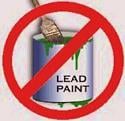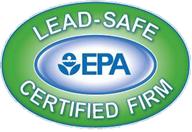New Shawn McCadden Videos About The EPA RRP Rule; RRP Information For Renovators
 I recently completed a series of seven videos about the new EPA RRP rule. The RRP videos were done for Remodeling magazine. They are posted to the Remodeling TV area of Remodeling magazine’s web site.
I recently completed a series of seven videos about the new EPA RRP rule. The RRP videos were done for Remodeling magazine. They are posted to the Remodeling TV area of Remodeling magazine’s web site.
The videos are sponsored by The Home Depot. The video series is titled “The Insider's Guide to the EPA's Renovation, Repair and Painting Rule”. The series covers critical information about the Environmental Protection Agency's RRP rule and certification process, and explains how the rule may affect your business.
I had a lot of fun doing the videos. Lots of great people donated their time, knowledge and expertise. I also learned a lot from  writing the script, interviewing contributors, editing the script with the magazine’s editor Sal Alfano, reviewing the raw footage, and working with the videographer, Chuck Greeen of Perpetual Motion Pictures. Working with Chuck was a unique advantage. As a fellow remodeler and Certified Renovator, Chuck not only filmed and edited the videos, he also contributed greatly to the content and success of the whole project.
writing the script, interviewing contributors, editing the script with the magazine’s editor Sal Alfano, reviewing the raw footage, and working with the videographer, Chuck Greeen of Perpetual Motion Pictures. Working with Chuck was a unique advantage. As a fellow remodeler and Certified Renovator, Chuck not only filmed and edited the videos, he also contributed greatly to the content and success of the whole project.
Here is a list of the videos, a brief description of what is discussed in each as well as links to view them:
Video One: The EPA RRP Rule and Your Business
This video covers the business responsibilities, associated liabilities and risks related to the RRP Rule. Kermit Baker, Senior Research Fellow at Harvard University's Joint Center for Housing Studies stresses that remodelers need to become experts in this area or leave the work to others who are. Attorney Mike Sams of Kenney & Sams, P.C. warns about the legal liabilities for failure to follow the regulations. Shawn McCadden discusses the firm and worker certification process, related fees as well as certified renovator and firm responsibilities.
Video Two: RRP Training
This video covers the worker training requirements of the rule and the content of the EPA Certified Renovator training class. Shawn McCadden also discusses the importance and benefits of choosing a training class conducted by a training instructor with real life renovation experience.
Video Three: EPA RRP Notification Requirements
The EPA RRP rule specifies certain notification requirements depending on where the work is done and who occupies and or visits the building being renovated. This video covers these requirements, related firm documentation requirements as well as the information and documentation that must be given to property owners and others. Shawn McCadden also discusses many of the important details that must be included in the required documentation.
Video Four: RRP Work Practices
This video includes a summary of the required lead-safe work practices required under the RRP Rule. Shawn McCadden walks through critical considerations related to the rule that must be followed to stay in compliance with the rule, protect occupants and workers and to control costs. Shawn also discusses interior and exterior cleaning and cleaning verification requirements.
Video Five: RRP Record Keeping
Inspection of the required documentation under the rule will be a major enforcement tool used by EPA. In this video Shawn McCadden discusses the required documentation related to worksite activities as well as many business administration activities. Mark Paskell of the Contractor Coaching Partnership shares a few of the many methods EPA will have at their disposal to inspect and verify a firm’s compliance with the rule. Shawn adds several more methods to Mark’s list and also discusses the penalties and fines EPA can assess on violators.
Video Six: Exemptions to RRP Work Practices
In this video Shawn McCadden gives examples of when, where and why the RRP rule and work practices are not required under the rule. Shawn stresses that even if the work practices are not required under the RRP rule, your business will still be liable if lead poisoning and or contamination results from the way work is performed. Shawn and contractor insurance expert Tom Messier of Mason and Mason Insurance both stress the importance of verifying proper and adequate insurance coverage to protect your business, available coverage options as well as related costs for coverage.
Video Seven: Business Considerations and Summary
Shawn Mccadden stresses that this new rule is a game changer. Shawn tells us businesses must take this new rule seriously and adjust their business practices accordingly to protect profits and control liabilities. Mark Paskell of the Contractor Coaching Partnership stresses that contractors should verify that the documentation forms they use will comply with the rule and also assist the business in managing and performing the work. Gerry McGonagle of Belfor Property Restoration offers his advice on qualifying the right employees to do the work. Shawn also discusses some of the new responsibilities the rule brings with it for employees in all positions within the business.
If you are looking for forms and signage to help you with comply with the EPA RRP rule, I recommend you check out what The Lead Paint Forms Store has to offer.

 as described within a scope of work for the project, test lead free by a Certified Risk Assessor, Lead Inspector or Certified Renovator
as described within a scope of work for the project, test lead free by a Certified Risk Assessor, Lead Inspector or Certified Renovator
 Looking for accurate information about the EPA RRP rule?
Looking for accurate information about the EPA RRP rule?  Renovators should be aware that in addition to EPA or administering states, other individuals or entities may likely take advantage of the documentation requirements to hold renovators accountable for their actions or lack thereof.
Renovators should be aware that in addition to EPA or administering states, other individuals or entities may likely take advantage of the documentation requirements to hold renovators accountable for their actions or lack thereof. OSHA could use RRP paperwork to prove non-compliance with its Lead in Construction Standards. OSHA’s worker protection requirements related to lead are very specific. Information contained in the required RRP documentation, particularly the renovation checklist and non-certified worker training documentation, could easily be used to show workers were not adequately trained and or protected when working in contained work areas. A lack of the required documentation could also be used by OSHA to demonstrate negligence by the business.
OSHA could use RRP paperwork to prove non-compliance with its Lead in Construction Standards. OSHA’s worker protection requirements related to lead are very specific. Information contained in the required RRP documentation, particularly the renovation checklist and non-certified worker training documentation, could easily be used to show workers were not adequately trained and or protected when working in contained work areas. A lack of the required documentation could also be used by OSHA to demonstrate negligence by the business.  I recently completed a series of seven videos about the new EPA RRP rule. The RRP videos were done for Remodeling magazine. They are posted to the Remodeling TV area of Remodeling magazine’s web site.
I recently completed a series of seven videos about the new EPA RRP rule. The RRP videos were done for Remodeling magazine. They are posted to the Remodeling TV area of Remodeling magazine’s web site. writing the script, interviewing contributors, editing the script with the magazine’s editor Sal Alfano, reviewing the raw footage, and working with the videographer,
writing the script, interviewing contributors, editing the script with the magazine’s editor Sal Alfano, reviewing the raw footage, and working with the videographer,  Many contractors seeking to comply with the new EPA RRP rule are reporting concerns and challenges about finding trade partners who are willing to operate in compliance. Many renovators have told me that their trade partners have flat out refused to get their businesses and workers certified. Others have said their trade partners have committed to do so but have been slow to get it done due to the related costs. This has become quite an opportunity for some trade partners who have become certified and are marketing their certifications and services to general contractors. Several are actually offering to sub-contract the set-up, containment, demo, clean-up, cleaning verification and all related and required documentation for general contractors.
Many contractors seeking to comply with the new EPA RRP rule are reporting concerns and challenges about finding trade partners who are willing to operate in compliance. Many renovators have told me that their trade partners have flat out refused to get their businesses and workers certified. Others have said their trade partners have committed to do so but have been slow to get it done due to the related costs. This has become quite an opportunity for some trade partners who have become certified and are marketing their certifications and services to general contractors. Several are actually offering to sub-contract the set-up, containment, demo, clean-up, cleaning verification and all related and required documentation for general contractors. Who will take care of the notification requirements and documentation of same before the job begins? Under the rule, either can do so, but the business under contract with the property owner must maintain the required documentation.
Who will take care of the notification requirements and documentation of same before the job begins? Under the rule, either can do so, but the business under contract with the property owner must maintain the required documentation. The first time a RRP fine is accessed for a violation the finger pointing will start, causing one or both businesses to get serious about certification and compliance. The first time a renovator is sued by a client or neighbor as a result of the actions of a trade partner, the tactics used by the lawyers will cause both businesses to have a new and different outlook on RRP compliance, insurance coverage amounts and indemnification clauses.
The first time a RRP fine is accessed for a violation the finger pointing will start, causing one or both businesses to get serious about certification and compliance. The first time a renovator is sued by a client or neighbor as a result of the actions of a trade partner, the tactics used by the lawyers will cause both businesses to have a new and different outlook on RRP compliance, insurance coverage amounts and indemnification clauses.  To confuse matters even further, under their definition of the difference between an employee and an independent contractor, the IRS says that a contractor cannot supervise the work or workers of a sub contractor. Doing so might result in the IRS labeling the sub contractor as an employee. If this were to happen it could trigger addition payroll taxes and workers compensation costs for the general contractor.
To confuse matters even further, under their definition of the difference between an employee and an independent contractor, the IRS says that a contractor cannot supervise the work or workers of a sub contractor. Doing so might result in the IRS labeling the sub contractor as an employee. If this were to happen it could trigger addition payroll taxes and workers compensation costs for the general contractor. Many liability insurance policies do not cover lead poisoning or contamination. Renovators should be sure they are working with an agent who is up on the EPA RRP rule and should sit down with their agent to review their coverage needs and options.
Many liability insurance policies do not cover lead poisoning or contamination. Renovators should be sure they are working with an agent who is up on the EPA RRP rule and should sit down with their agent to review their coverage needs and options.  Increased risk of liability due to lead awareness as well as the government mandated certification requirements are likely to affect a renovator’s ability to get a policy as well as the premium charged by carriers who offer coverage. Tom told me he predicts that existing policies will not be renewed unless a renovator can show they are certified firms and use certified renovators to oversee the work their company performs. He also predicts insurance carriers will start requiring the insured’s proof of compliance with the rule as well as proof of compliance and insurance coverage for the trade partners the insured renovator works with. Tom stressed that this would be for both liability as well as workers compensation insurance coverages. He said that even if they are self-employed, insurance carriers will likely require all trade partners have their own workers compensation policies as a way to prevent injured or poisoned trade partners from claiming against the general contractor’s policy.
Increased risk of liability due to lead awareness as well as the government mandated certification requirements are likely to affect a renovator’s ability to get a policy as well as the premium charged by carriers who offer coverage. Tom told me he predicts that existing policies will not be renewed unless a renovator can show they are certified firms and use certified renovators to oversee the work their company performs. He also predicts insurance carriers will start requiring the insured’s proof of compliance with the rule as well as proof of compliance and insurance coverage for the trade partners the insured renovator works with. Tom stressed that this would be for both liability as well as workers compensation insurance coverages. He said that even if they are self-employed, insurance carriers will likely require all trade partners have their own workers compensation policies as a way to prevent injured or poisoned trade partners from claiming against the general contractor’s policy.  One other area that will likely be of concern is lead coverage in policies for landlords who own pre-1978 properties. Here too, compliance with RRP rules and documentation of work practices used for renovations and repairs will likely become required conditions of obtaining and keeping coverage. The EPA RRP rule may also cause an increase in insurance coverage on properties built prior to 1978, for landlords and maybe even home owners.
One other area that will likely be of concern is lead coverage in policies for landlords who own pre-1978 properties. Here too, compliance with RRP rules and documentation of work practices used for renovations and repairs will likely become required conditions of obtaining and keeping coverage. The EPA RRP rule may also cause an increase in insurance coverage on properties built prior to 1978, for landlords and maybe even home owners.


